
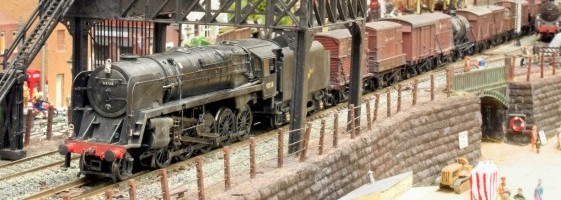
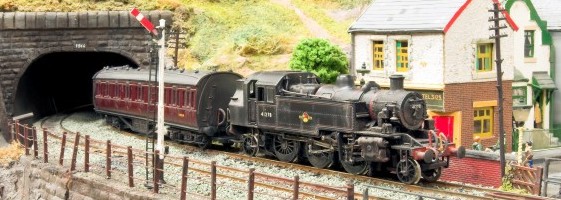
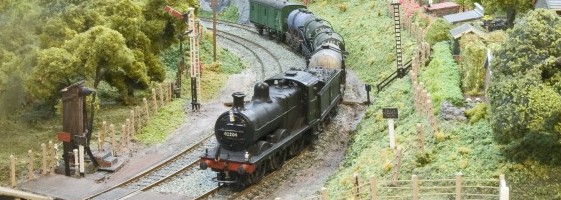
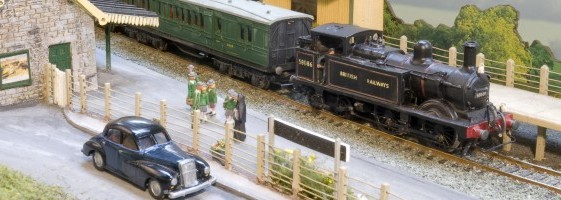
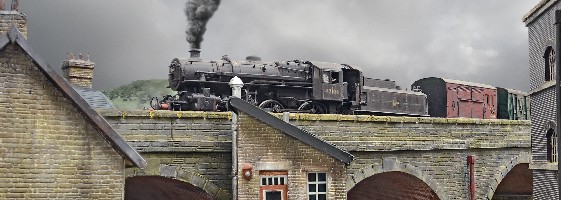
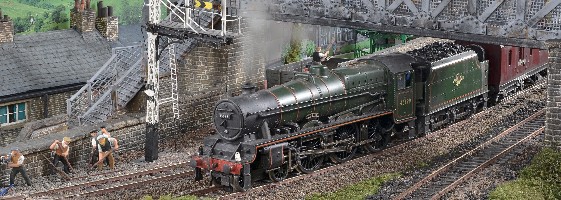
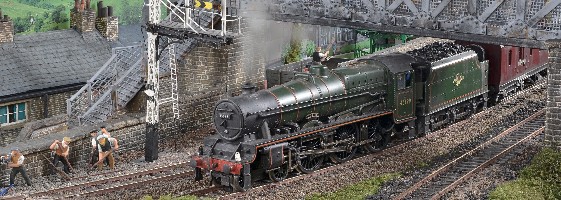








 The
Station of Studley and Astwood Bank station was
situated 3 miles and 11 chains south of Redditch
and was opened on Monday 4th May 1868 to both passenger and
goods traffic. The station was provided with a large
brick two-storey building accommodating the station
master's family and an attached single storey
structure within which the passenger services were
provided; namely a booking office, booking hall,
ladies waiting room and a general waiting room. The
goods shed was equipped with a fixed position 30 cwt
(one and half ton) hand operated crane which could
revolve 360 degrees within the shed. A separate
office was built at the Redditch end of the shed.
Within the station access road was a weighbridge and
office. Beside the weighbridge there was for many
year even after closure a grounded coach body. The
yard capacity was fifty-five wagons with the entry
from the Redditch end controlled by ground frame
released by the single line tablet.
The
Station of Studley and Astwood Bank station was
situated 3 miles and 11 chains south of Redditch
and was opened on Monday 4th May 1868 to both passenger and
goods traffic. The station was provided with a large
brick two-storey building accommodating the station
master's family and an attached single storey
structure within which the passenger services were
provided; namely a booking office, booking hall,
ladies waiting room and a general waiting room. The
goods shed was equipped with a fixed position 30 cwt
(one and half ton) hand operated crane which could
revolve 360 degrees within the shed. A separate
office was built at the Redditch end of the shed.
Within the station access road was a weighbridge and
office. Beside the weighbridge there was for many
year even after closure a grounded coach body. The
yard capacity was fifty-five wagons with the entry
from the Redditch end controlled by ground frame
released by the single line tablet.
Station Freight Traffic
Three coal merchants were based in the yard at Studley and Astwood Bank Station and these were:
Alcester Co-operative whose head office was in Evesham Road, Alcester.
Thomas and Mathew Dixon better know locally as T&M Dixon (their main depot was at Redditch where they had their own own sidings). T&M Dixon also had coal facilities at Evesham and were the owners of Tardebigge orchards. In latter years both the Redditch and Evesham facilities were given over to the sale of Austin and subsequently Leyland cars and petrol.
Edgar Shrimpton of Sambourne Lane, Astwood Bank. The Shrimpton family started in business in Redditch making needles and this bsiness became Alfred Shrimpton (Needles) Limited and was to which remain in business until 2006. Edgar Shrimpton left the family needle making business in the early part of the 20th century to set up as a coal merchant based at both Redditch and Studley and Astwood Bank railway stations.
By the 1950s there were three main types of freight handled at Studley and Astwood Bank Station. The first being coal supplied through the three coal merchants based at the station. Their coal in the main came from from local collieries in the Cannock area such as Birch Coppice or Coventry area from Arley Colliery. The second was timber to timber yards next to the station and the third was general parcels for customers over a wide area including fertilizer for local farmers, general goods for customers in the Studley, Astwood Bank and Sambourne area.
The standard Midland Railway signal box controlled the southern access to the yard. The first signal box at the station was opened prior to 1st November 1975 and was replaced by a second signal box that opened on Monday 25th May 1891. In latter years the signal box was only open each day for around eight hours so as to allow the pick up freight trains access to the yard and was for the rest of the time switch out.
Station Closure
Passenger services for the station were suspended after operation on the Saturday 29th September 1962 due to the condition of track between Alcester and Evesham. This was not helped by the fact during 1960 and 1961 the line had been heavily used as a diversionary route for traffic from the Lickey Incline due to engineering work on that line. From Sunday 30th September 1962 a replacement bus service was operated by Midland Red that called at all stations until Monday 6th July 1964 between Redditch an Evesham. The line between Redditch and Alcester remained open for freight until Monday 6th July 1964. Passenger usage at Studley and Astwood Bank was by this time very poor for example during the whole month of March 1962 only 28 tickets were sold for travel from the station. Freight facilities were withdrawn from Monday 17th June 1963 prior to the closure of the line from Monday 6th July 1964 when freight facilities were withdrawn from Alcester station.
Life after closure
After closure the station remained intact for many
years. Much of the station site and the trackbed
between Redditch and Studley had been purchased by
the Redditch Development Corporation in the late
1960ís for use in the construction of the new town. During 2015 the station house and building
were sold and continue to be used as a single
dwelling. The good shed was demolished and during
2016 a number of houses have been built on a large
part of the former station yard.